The medieval done right: Lion Rampant Ver 2
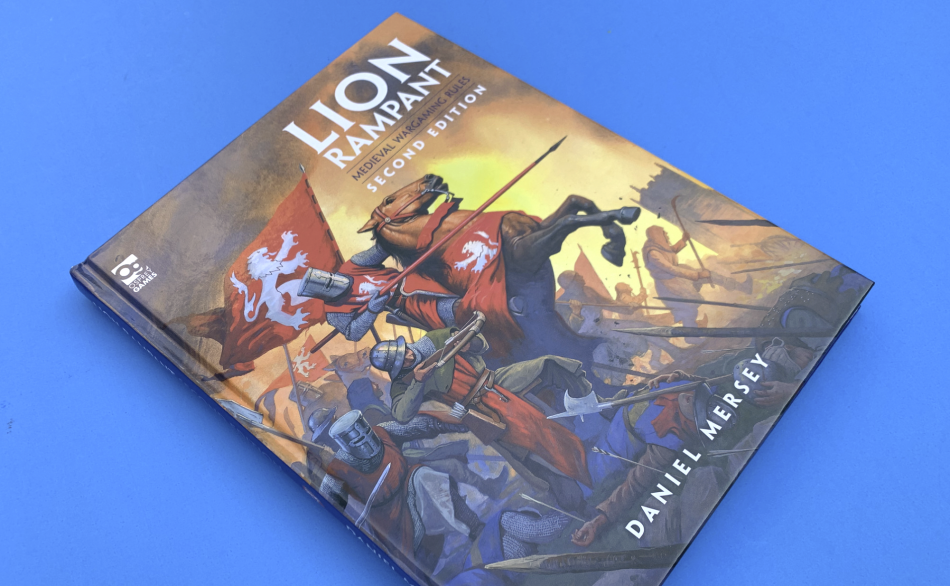

By Troy A. Hill
When it comes to gateway drugs in miniature wargaming, a historical period like the dark or middle ages isn’t a period one would expect to draw in new miniatures table-top wargamers. Is Lion Rampant Second Edition that gateway drug?
Is it another Song of Ice and Fire miniatures game that can use pop culture to bridge Hollywood fans into table-top gaming like a Crisis Protocol game for a certain Comic-to-Movie franchise? Or even a historical game with interesting meta-gaming twists like Saga and their battle board/saga dice system?
Is it a game that can draw in the Win At All Cost (WAAC) meta netlist players from that space orc game, and get them to play historicals?
Probably not, unfortunately. But, it is a stand-alone game in a crowded field of historical and fantasy-style historical-esque games. It’s a welcome addition to my gaming library.
If we ignore the fantasy games that draw heavily from the dark and middle ages and focus only on historical gaming for this period, there are already a sizable number of games for this medieval period. Some companies like Warlord Games shoehorn this time period into a supplement between two of their main ground-pounding games. The medieval crusades are close to, but not quite ready for their Pike and Shotte (P&S) Rules. Nor does the time period slide into their rules for Hail Caesar (HC), despite the addition of the Shieldwall addendum book that refers back to the HC sourcebook.
That’s where a game system like Lion Rampant has found its niche.
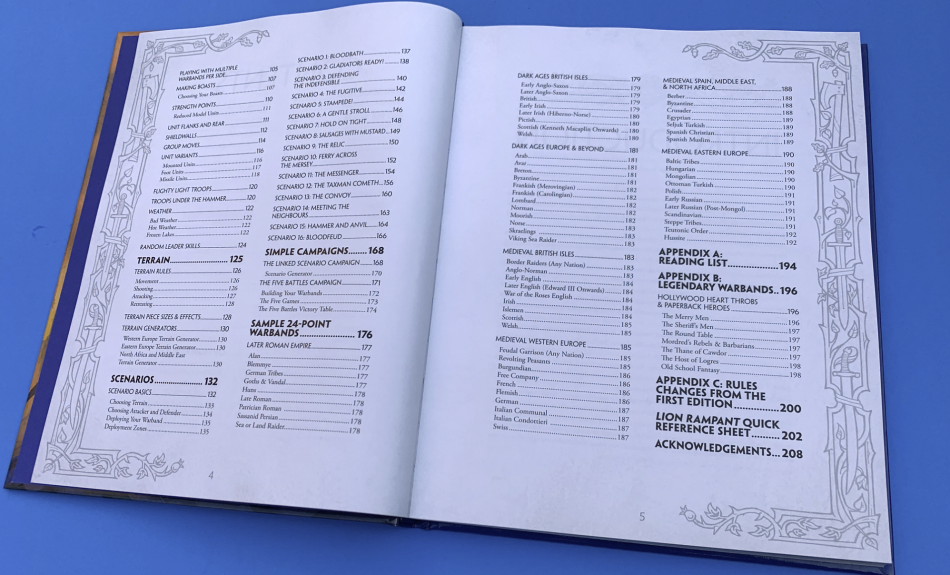
When I spent four years in California in the late 20-teens, a friend kept trying to get me to play Lion Rampant in its first edition. To my regret now, I never made the time for it. (Sorry Ron, I should have gotten a game in). I even passed up a time or two at the local SoCal HMGS or local convention.
You see, my gateway drug into historical gaming was through WWII. First Flames of War, then Bolt Action. I grew up in the USA at the tail end of the John Birch Society era. As such, my world history education began with Christopher Columbus and ended with the roaring twenties and a week or two on how the US handled the great depression. Wait? There is history in other parts of the world?
So, now I sit at my gaming table/club/convention, trying to learn history by enjoying table-top miniature gaming.
Before I dive into what Lion Rampant is, for those who aren’t already familiar, let’s address the other 300-pound Crusader Knight in the room, Saga: Age of Crusades (AoC).
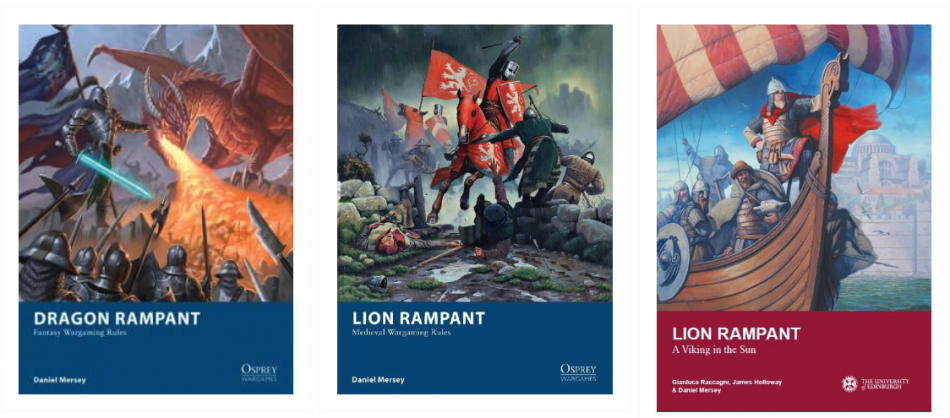
I admit that Saga is my current game du jour. And the AoC is my favorite of the ages within that system. Both AoC and Lion Rampant cover the Crusades with game systems built around 28mm figures in skirmish squad formation. But, where the Saga system begins with a simplistic game system and layers on a meta-heavy element in the battle board and Saga dice system, Lion Rampant stays simplistic. They are two different approaches to gaming the period. Each game has its own strengths and will appeal to different parts of the gaming psyche.
The Rules
Lion Rampant is built for squads of 28mm figures, using inches and d6s. It is a U-go-I-go system with some tweaks. The core rules pass the turn initiative or activation to the other player when a squad or unit fails an order check. There are three kinds of orders: Move, Shoot, and Attack. Some troops also get the option to skirmish in this phase.
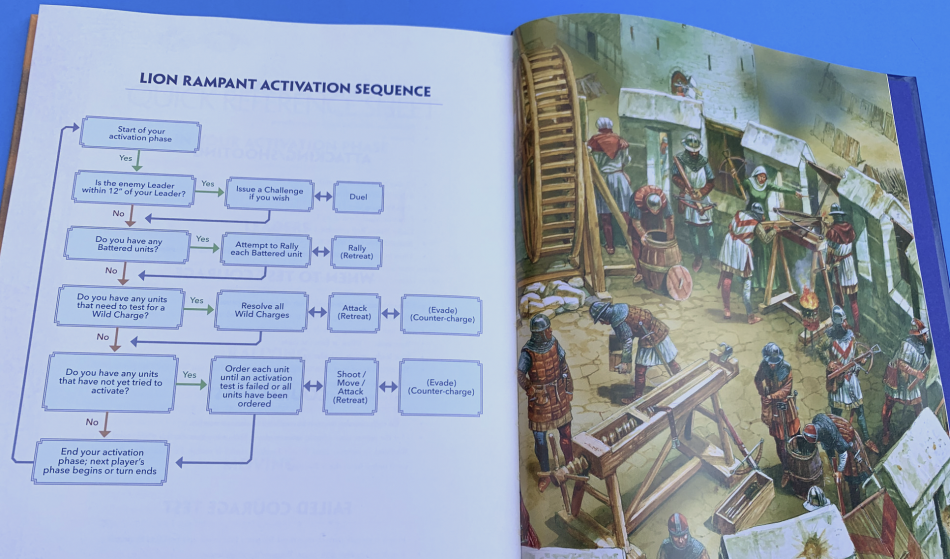
If you want your unit of Templar Crossbowmen to fire at the enemy, give them a Shoot order. Page 95 has the stat block for Crossbowmen. Their shoot test value is a 7+. The player then rolls 2d6 and needs a cumulative 7 or better on the roll.
Each unit may make one activation per its player’s turn.
But, according to the core rules, if you need to clear away a pesky unit before moving your knights up, and order your crossbowmen to shoot, then roll a 6 or less on the order test, your turn would end, and the activation passes to the other player. UNLESS your leader figure is within twelve inches of the unit that failed its order check. The leader grants a reroll to this check. But, there are some caveats. Only Move, shoot, or attack orders may be rerolled, and only if the leader is within twelve inches. If the leader is in a Battered status, they do not grant this re-roll.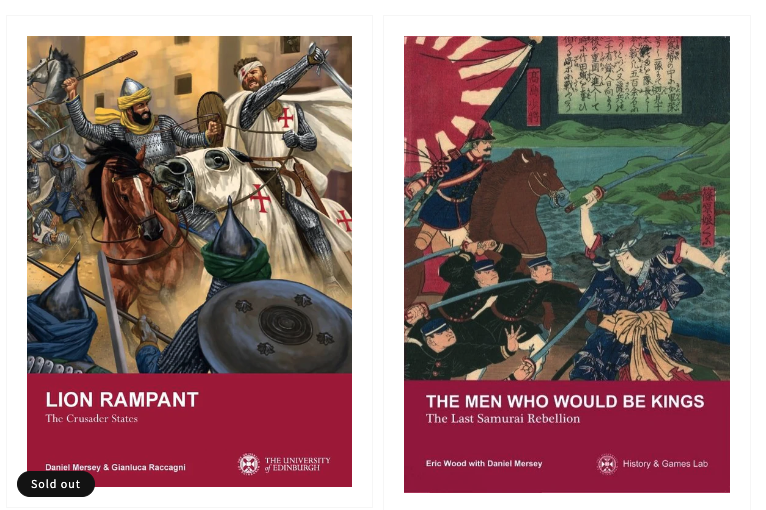
The Changes
When the first edition of the game appeared in the mid-twenty-teens (now called the Blue Book version), it was popular enough to get addendums and write-ups in magazines and blogs. Additional sourcebooks, like Dragon Rampant (a fantasy variation), The Men Who Would be Kings: The Last Samurai Rebellion took the game system into new avenues. Two additional sourcebooks: Lion Rampant: A Viking in the Sun, and Lion Rampant: The Crusader Series were both written with an eye toward this new 2nd Edition.
Some highlights of changes from the first edition:
- Leaders pay for skills other than their command skill
- A failed wild charge does not negate an attempt to move later in the turn sequence
- Retreats that are within a move of the table edge must flee off the table
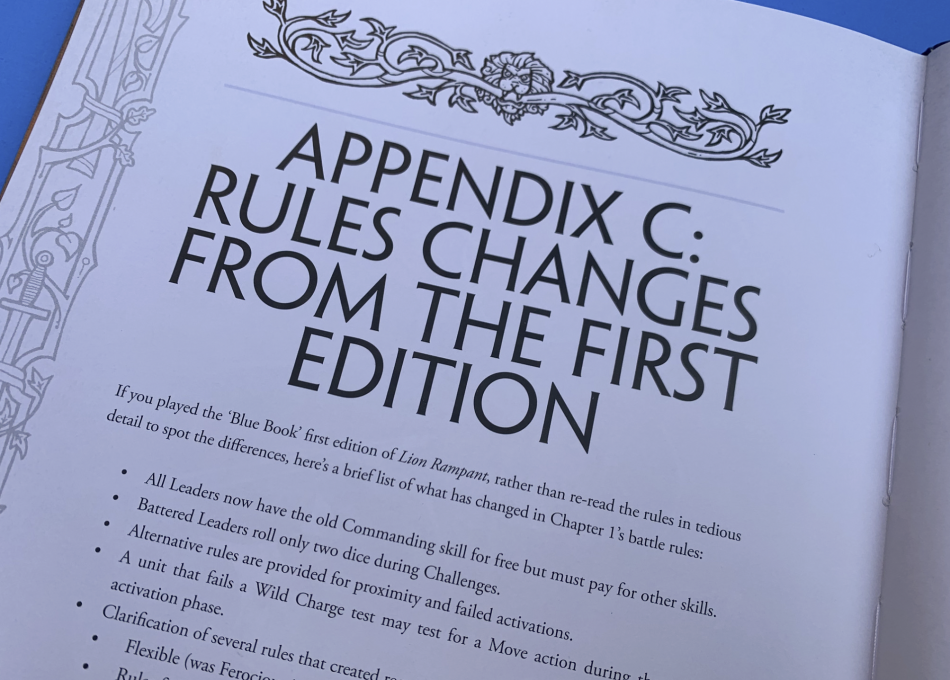
Other changes include incorporating “house rules” as optional rules. Agree with your opponent ahead of time. These include ignoring the failed order test that would normally end your turn (IMO: Good for large convention games, or for players like me that the dice gods take pleasure in tormenting). Also, unit spacing is standardized with three-inch gaps between units. However, many players house-ruled this down to one-inch gaps. That is now listed as optional (agree with your opponent).
Lion Rampant also includes a system of Boasts, that has moved into the optional category, What is boasts?
A series of mini-missions that players declare before the game. Tasks such as destroying the enemy warlord, or driving them back into the sea have either 1, 2, or 3 bonus glory points attached, and are in addition to glory points awarded by missions/scenarios players use to compete. Making Boasts optional seems like a sound idea. Some players just want a battle royale, others may want to finesse their troops for additional achievements.
What else is in the book? Add the mustard
In addition to the expanded rules, players will find basic warband unit stats, rules, and suggestions for building warbands, terrain rules, and sixteen scenarios, several of which are new for this edition.

The system stays simplistic in its warband construction. Much like Saga’s minimalist approach to units, Lion Rampant shares the concept. Instead of differentiating between types of Heavy Cavalry, the unit is what it is. Dudes in armor on big horses. (Or camels if you’re using option rules for camels. But, Elite Cavalry and Light Cavalry are all different types of units. The LR book gives lists of sample 24-point warbands, broken down by ages. Due to the simplistic nature of a warrior with a bow is the same across ages in this game, I can see fielding Dark Ages late Roman empire troops against Crusader knights for an entertaining game, if one so desires.
Shooting and Combat
Overall, this is a standard make an order test. If successful, shoot or charge into combat. If your unit is above half strength, roll 12 d6 to hit your opponent’s unit. If your unit is under half strength, roll 6 d6. No more counting up figures and multiplying by number of attack dice.
Since each unit type has an armor value, just equal or beat that on the dice to inflict casualties. Elite Infantry has an armor of 4, so a 4+ to inflict wounds on them. For comparison, Light Infantry units have an armor of 3, while units of Levy have an armor value of one.
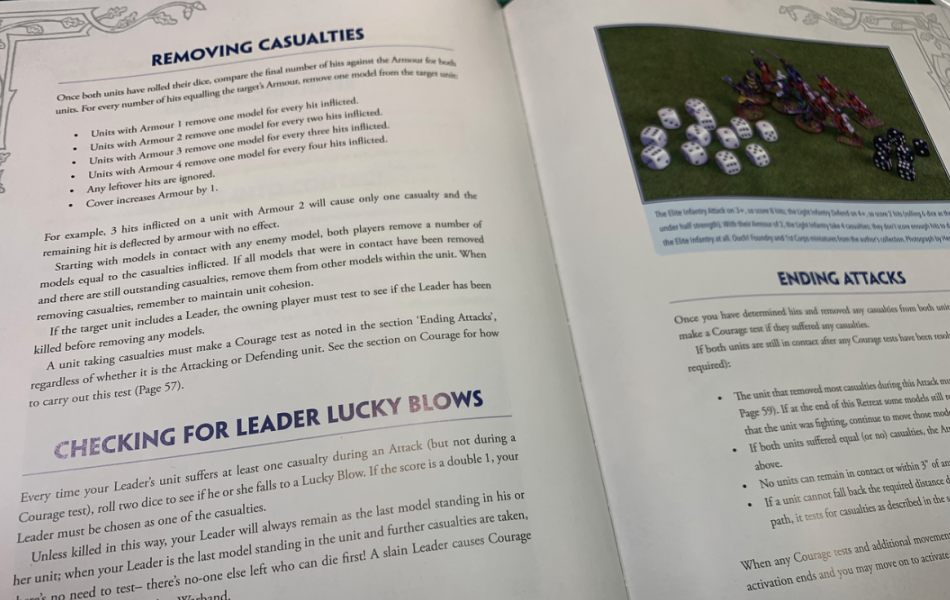 Now for the tricky part. You do have to remember numbers. But it’s easy to do so. The number of casualties from shooting or combat is tied to the armor value of the target unit. Levies with armor one take one casualty for each die that scores a hit. Yep, levy drop like flies. The aforementioned heavy cavalry with an armor of four, take one casualty for every four dice that hit. Armor two takes a casualty for every two hits rolled, etc.
Now for the tricky part. You do have to remember numbers. But it’s easy to do so. The number of casualties from shooting or combat is tied to the armor value of the target unit. Levies with armor one take one casualty for each die that scores a hit. Yep, levy drop like flies. The aforementioned heavy cavalry with an armor of four, take one casualty for every four dice that hit. Armor two takes a casualty for every two hits rolled, etc.
This neat little system bypasses the standard mode of roll to hit, roll to wound or save.
It’s over Anakin!
Yes, in the terrain section, there is a rule that defenders on a hill, above their attackers, count as in cover. This gives the defending unit a +1 bonus to their armor.
Terrain is basically broken into five potential types: rough, obstacles, Obscuring, Cover, and Impassable. Most do what you expect them to. Cover provides a bonus to armor, Rough Terrain slows movement by half (for travel within. A figure that goes through two inches of rough ground, counts as moving four inches.
My thoughts and appraisal
Back to the original theme, I noted in this article. Is Lion Rampant a gateway game to bring people into the hobby en-masse? Probably not.

There may be the odd experience of a history instructor enticing students through the game in the classroom as a teaching aid, but I don’t see this game taking off as Saga has. The latter shares many traits with Lion Rampant, but where Saga can be a bridge game between our historical gaming and that standard space apocolypse game we all know and love to complain about the meta-win-at-all-costs tourney players. The challenge in that bridge is to tamp down the WAAC attitude the space game breeds in its players and get our new historical players to enjoy both the history and the fun without the meta-driven battle lust.
Overall, based on my initial read-through, I give Lion Rampant Second Edition a solid thumbs up. The rules are simple but can give complexity to both the tabletop strategy, as well as force-building. But, the latter won’t be easy to overpower since the game is designed with basic troop types, standardized weapons, and a major lack of meta-crunchiness. To some players, that might be a detriment that would keep them playing with space orcs. For other players, it may be just the ticket.
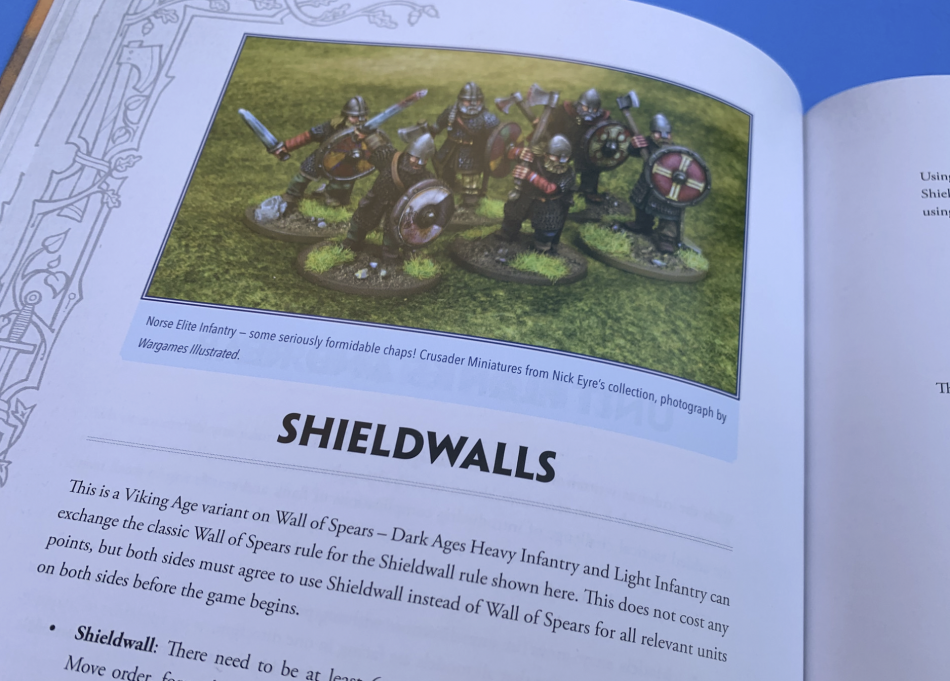
After all, this hobby, for most of us, is about gaming with friends. That includes rolling dice, moving little toy soldiers, and generating battle stories about our little soldiers. I’ll take the latter over WAAC space orcs or meta-gaming historical players looking to dominate with a net-list any day. The after-action tales of dice failures and hail-mary rousing successes told over pints of frosty or frothy beverages are as much a part of why I game as is learning about history, and painting my figures.
Lion Rampant isn’t really a gateway into historical gaming. But it is a gateway to sensible fun with your drinking buddies (whether you prefer wine, ale, beer, or coffee).
If you want a fun game system for dark age and medieval scenarios, whether in 28mm scale, or something smaller, Lion Rampant can fit that bill. It’s worth the $30 (US) to pick up. I expect to see this in many a historical gaming club, game day, or convention.
Now, I just need to find a copy of the 2019 Lion Rampant: The Crusader States. I’ve got a load of Hospitallers to paint up.
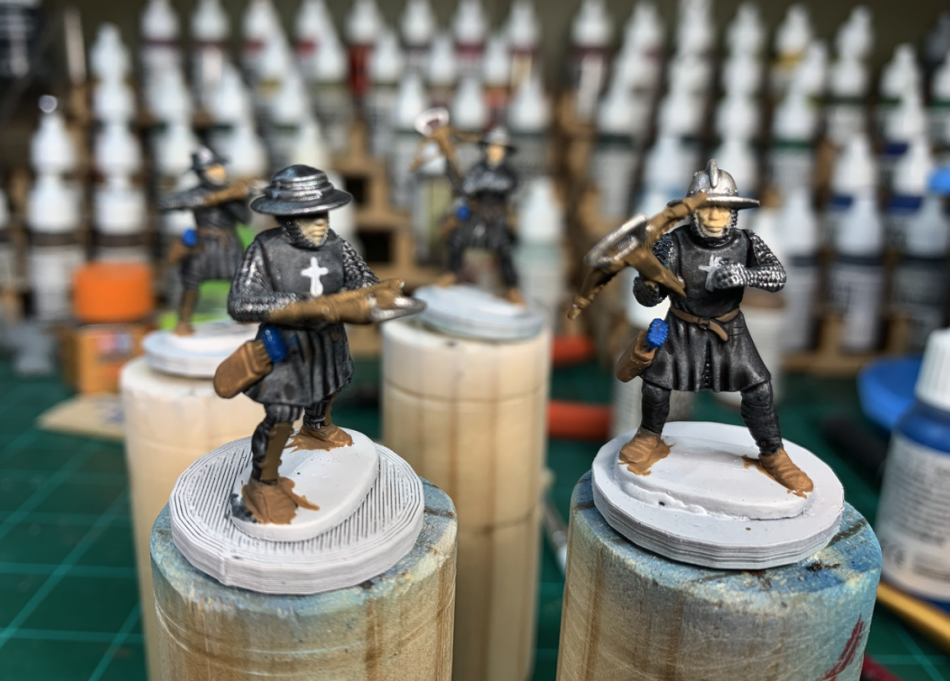

Lion Rampant Crusader states can be purchased via Drive thru Rpg. This where I got my copy. Great articles.